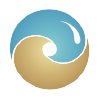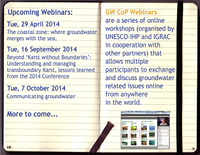Webinar #3
DATE: Tuesday 29 April 2014, 14:00 – 16:00 CET
AGENDA:
14:00 – 14:05 Welcome to participants
14:05 – 14:15 “Coastal aquifers and their interactions with the marine environment – The case of the Mediterranean Sea Large Martine Ecosystem” by Matthew Lagod, UNESCO-IHP
14:15 – 14:35 “Integrating consideration of coastal aquifers into the GEF Transboundary Diagnostic Analysis-Strategic Action Program process of the GEF International Waters focal area - A first example in the Mediterranean Sea” by Andrea Merla, UNESCO-IHP and Raya Stephan, UNESCO-IHP
14:35 – 14:45 Moderated discussion with the participants
14:45 – 15:20 “UNESCO-IHP coastal aquifer pilot projects in the Mediterranean”
- Overview (Matthew Lagod, UNESCO-IHP)
- Hydrogeochemistry as a tool for coastal aquifers management – the case of the Bou Areg aquifer and the Nador Lagoon (Morocco) (Viviana Re, Ca' Foscari University Venice)
- Vulnerability mapping of coastal aquifers
- Novljanska Zrnovnica karstic spring catchment area (Croatia) (Ranko Biondić, University of Zagreb)
- Pula coastal aquifer (Croatia) (Mladen Kuhta, Croatian Geological Survey)
- Ghar El Melh coastal aquifer (Tunisia) (Salvatore Carrubba, Consultant, UNESCO-IHP)
- Conjunctive management of surface and groundwater resources
- Buna/Bojana Transboundary Integrated Management Plan (Albania and Montenegro) (Dimitris Faloutsos, Programme Officer, GWP-Med, to be confirmed)
- Reghaia’s Coastal Plan (Algeria) (Veronique Evers, Consultant, PAP/RAC)
15:20 – 15:25 “A platform for sharing project knowledge: the web-based coastal aquifer information system” by Matthew Lagod, UNESCO-IHP
15:25 – 15:35 “The way forward and conclusions” by Andrea Merla, UNESCO-IHP
15:35 – 15:55: Moderated discussion with participants
15:55 – 16:00: Closing
BACKGROUND: UNESCO’s International Hydrological Programme (IHP) is executing a component of the GEF/UNEP-MAP Strategic Partnership for the Mediterranean Sea Large Marine Ecosystem (MedPartnership) Project on coastal aquifers and groundwater. The Project is being carried out in the following GEF eligible countries: Albania, Algeria, Bosnia and Herzegovina, Croatia, Egypt, Lebanon, Libya, Morocco, Montenegro, Syria, Tunisia and Turkey. The Palestinian Authority also participates.
A Transboundary Diagnostic Analysis carried out for the Mediterranean Sea Large Marine Ecosystem (TDA-MED) in 1997 and updated in 2005 did not recognize the importance of coastal aquifers in sustaining coastal marine ecosystems and providing critical drinking water supplies and livelihoods to coastal communities and their economic activities (tourism among others).
Within the context of the UNEP GEF MedPartnership project, UNESCO was called to fill this important gap and produce:
(i) A supplement to the TDA-MED 2005 that would address, for the first time in GEF IW marine projects, the state of coastal aquifers, the transboundary implications that their degradation might imply for the integrity of the coastal marine environment, and the present relevant legal policy framework within which they are utilized, managed and protected.
(ii) A set of recommended priority actions aimed at reducing the stress on coastal aquifers and preserve their vital environmental and socio-economic roles, as a complement to SAP MED and SAP BIO;
(iii) A regional action plan on coastal aquifers for consideration by the littoral countries, parties to the Barcelona Convention.
UNESCO’s work on coastal aquifers within the context of MedPartnership, carried out together with the GEF eligible countries, is now approaching its final stage, when conclusions will be drawn and recommendations formulated. The webinar that is being organized has the objective to present to the Mediterranean stakeholders and groundwater practitioners at large, the work done so far and the participatory process that will be followed in finalizing the TDA Supplement and other key products.
Recorded Video of the Session:







